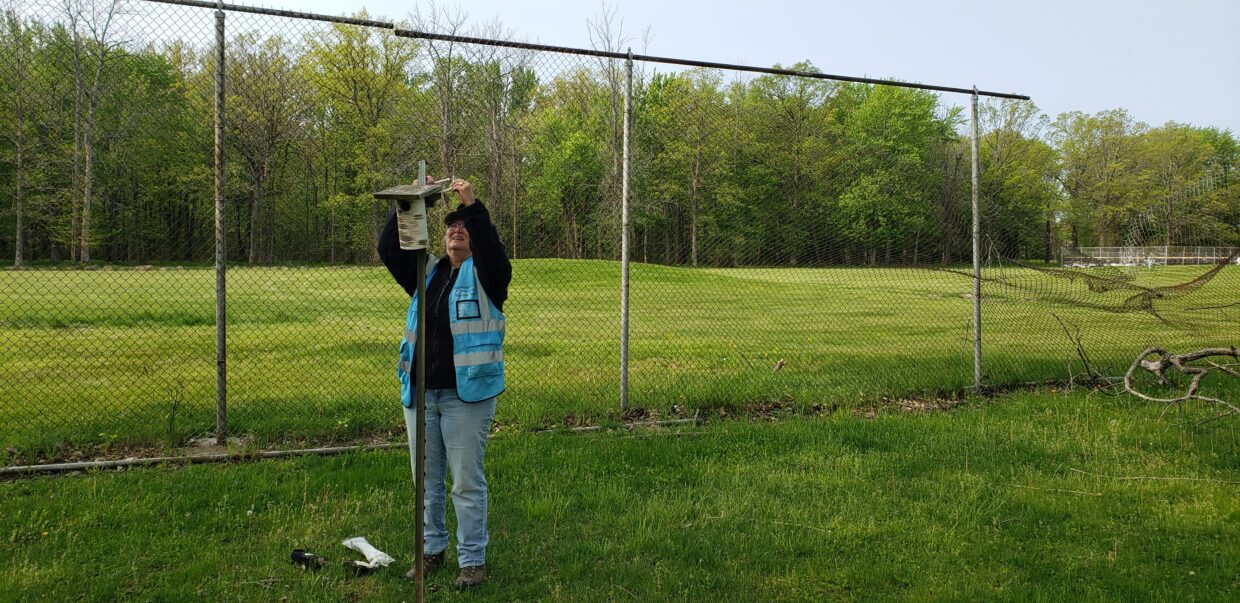When managing Bluebird nest boxes, we try to keep our checks quick and non-invasive. Sometimes that is easier said than done, especially regarding nest box maintenance. We would love for every one of our boxes to have Bluebird young survive to fledge, but accidents and nature happen, and we have to step in to help. One of our nest boxes needed some special care recently, and we had to be sure we didn’t do more harm than good.
We recommend mounting nest boxes on free-standing poles over posting them on trees, houses, or fence posts. Most of our boxes are on poles, but we still had two Gilbertson-style boxes on the driving range fence at a golf course. We had planned to move the boxes for two seasons but had yet to get around to it, especially since they produced so many fledglings.
The fence received significant damage from a recent storm, and since the boxes were empty, we took advantage of the opportunity to make some improvements. We headed out to relocate the boxes with poles and post-driver in hand. Unfortunately, a pair of Bluebirds built a nest and laid one egg in one of the boxes since our last check.
The last thing we wanted to do was interrupt a nesting cycle, but the fence was in bad shape, and we knew the groundskeepers would need to repair it. If there was an empty nest in the box and we moved it, the adults might abandon the attempt, but they are usually invested in a nest once they lay an egg in it—this is also a great time to temporarily attach a Sparrow Spooker to the box.
We took some time to monitor the site and verify the adults were still in the area. After that, we decided to move the box just far enough from the fence for crews to work and keep it within site of its original spot.

Volunteer Cheryl Cantlon mounts an occupied Bluebird nest box on a new pole.© A. T. Baron
After placing the pole and mounting the box, we observed the adults from a safe distance. The male and female remained in the vicinity and landed atop the fence. At one point, they even chased away a sparrow from the area. Defending the nesting area was a great sign, but I wanted to be sure they were truly invested in their box before I left.
I grabbed my binoculars and found a spot by a distant tree to watch the adult Bluebirds. They swooped down from the fence to snatch some bugs. They flitted from one branch to another. They even took some time to preen their feathers, but neither had landed on the box.

Male Eastern Bluebird on a fence.
Stray golf balls from the driving range ricocheted off the trees around me. I didn’t realize my spot was that precarious when I sat down, but I risked watching the birds a little longer while I entered notes from our maintenance onto the NestWatch app.
After a few minutes, the female Bluebird alighted on the nest box. The wind rustled her feathers, and she flew to join the male on a nearby branch while another ball careened off a tree with a thud. I wanted to see if she or the male would enter the box, but I thought it best to high-tail it out of there and settle for them knowing where the nest was.
We were happy to find additional eggs in the nest at our next check, and we are calling the move a success. It’s never easy being a steward of nature. We have to know when to let nature takes its course and when to intercede. Just because we can help, doesn’t mean we should, and a good steward knows the difference. It’s times like this, when we successfully move the nest box, that we can reap the rewards.

